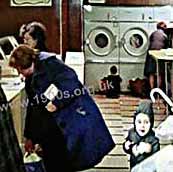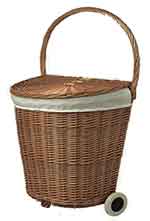The laundrette, 1950s-60s UK

Laundrettes, also known as laundromats, were self-service laundries where people could wash and dry their clothes using coin-operated machines. In the 1950s, they sprang up in shopping centres in almost every town, and were always well-used. This page explains why they were so popular and describes the experience of using them.
____
By the webmaster based on her early 1960s weekly use of laundrettes, discussions with others and additional research
Why laundrettes were so popular
Although twin tub washing machines had arrived in the 1950s, few ordinary people could afford them - and certainly they were well out of reach for newly married couples such as my husband and myself in the early 1960s. The solution was to go the laundrette. So, like most recently married couples, we went to the local laundrette once a week taking our dirty washing with us. We walked with it, as did other people, pulling it behind us in our basket on wheels.

Cane basket on wheels, popular for shopping in the mid-20th Century UK and useful for carrying washing to and from a laundrette
These baskets were popular, too, because cars were to expensive for the likes of us. They were made if cane, also known as wicker work. The cover shown in the image was an early plastic that discoloured and tore easily. Few people bothered with it.
Inside the laundrette
Coin operated washing machines lined at one of the longer walls. At the laundrette that I used, they were all top loading.
The opposite wall was where the assistant sat at a table with scales for weighing the wash. I think it has a drawer in it for extra payments and her own personal belongings. I don't think there was a cash register, but this must have depended on the laundrette.
On the same wall were tumble driers which were front-loading and also coin operated.
In the centre was a line of seats for customers to use while waiting for the wash to finish.
What happened at a laundrette
On arrival, having ensured that we had the right coins for the machines, the assistant weighed our washing. We had to be careful not to be over the allowed weight and be prepared to grovel if our washing included anything already wet which, was always heavy.
The washing powder always seemed to be supplied by the assistant at the time of weighing. This was probably to ensure that the right amount and right sort of low-lather powder was used, so to prevent stealing and suds spilling blocking the machines.
While the dirty washing was being washed and rinsed, it was a time for sitting down on the provided seats and watching other people, or reading or just musing. It was quite hypnotic watching the washing going round and round.
The laundrette as a social centre
I can't remember how long a wash took, probably about half an hour. People were said to meet people and make friends while waiting in laundrettes.
Drying the laundry
We had to get up to look to see when our washing machine had stopped. Then we had to decide whether or not to use one of the tumble dryers which were on another wall. They were front loading.
There was usually a wait for a tumble dryer because there weren't many of them - and anyway they took more coins, and money was short for newly weds. Usually we decided to take the wet washing home to dry with our Flatley. There were no radiators in the sort of flat that we or our contemporaries could afford at the time, on the top floor of a suburban semi.
We also of course still had to do the ironing, but the laundrette was a lot better than having to do the washing the way our grandmothers did.
The end of laundrettes
As people became more affluent, or perhaps as domestic washing machines became cheaper, laundrettes became progressively less-used. They still remain in an updated form in specialist areas such as universities where the local population is living in some sort of temporary accommodation, but they are seldom seen today in town shopping centres.
| sources | webmaster | contact |
Text and images are copyright
If you can add anything to this page or provide a photo, please contact me.



